Category
For Windows users
- Getting started
- Synchronization
- Sharing
- Remote access
- Sync photos and videos automatically
- Managing the synchronization
Getting started
Qsync is a cloud based file synchronization service empowered by QNAP Turbo NAS. Simply add files to your local Qsync folder, and they will be available on your Turbo NAS and all its connected devices.
Before using Qsync
Follow the 3 steps below before Qsync deployment.。
- Create user accounts on the NAS,
- Install Qsync on your computers and Qfile on your mobile devices.
- Log into the NAS (serving as a Qsync server) from your computers or mobile devices (referred to in this document as Qsync clients.)
Create user account on the NAS
Please create user accounts for Qsync users.
For NAS administrator: Please go to “Control Panel” > “Privilege Settings” > “Users” > Click on “Create.”
For NAS users: Please have the system administrator create an account for you.
Install Qsync utility
Qsync will synchronize all chosen files on your computers or mobile devices.
Follow instructions detailed on the “Overview” page to download the utility. (Log into the NAS> Click the Qsync shortcut on the NAS Desktop> Overview page)
Or download the utility from the QNAP website: Support > Download> Utilities.
For computers, please download the Qsync utility for Windows.
For mobile devices, please download and install Qfile for iOS or Android.
Log into the NAS
After installing the utility, enter the user ID and password and specify the designated NAS as the Qsync server.
To locate the NAS within a LAN environment, simply click “Search” to find it or key in its IP address or name. (e.g. IP address: 10.8.1.20 or 192.168.1.100)
To connect to a remote NAS (over the Internet), please use your myQNAPCloud address to log in. (e.g. andy@myQNAPcloud.com )
Note:
- If the ports have been changed for NAS connection, please append the port number to the IP address; otherwise, please only enter an IP address. (Default port number: 8080)
Start using Qsync
Double click on the Qsync shortcut on the Windows desktop to open the Qsync local folder. Click on the Qsync icon on the taskbar at bottom right side of the screen to bring up the menu.
Now, just copy or move your files to the local Qsync folder in one of your devices, the files will be copied to all your other devices (devices with Qsync installed and are connected to the NAS.)
From now on, you don’t need to copy files back and forth between your PC and external devices or worry about the size of the files as you to try to attach them to an E-mail.
Synchronization
Synchronization
There are a few methods you can synchronize your files. Qsync will automatically synchronize the files among your computers or mobile devices that have Qsync installed, and they will also be synchronized to the Qsync folder on the NAS.
- For PCs, drag and drop files directly to the local Qsync folder.
- For mobile devices (Qfile), copy or move files into the Qsync folder.
- For the NAS, copy or move files to the Qsync folder via File Station (web based file explorer).
Note:
- If files are “dragged and dropped” into the Qsync folder, they will be moved to the Qsync folder, as supposed to be copied into the folder, if the files and the Qsync folder are located in the same disk drive. The behavior is the same as File Explore in Windows.
- The maximum size of a single file that Qsync can transmit is 50G in a LAN.
- Qsync doesn’t support SAMBA, FTP or AFP for files access. Please access files using File Station or Qsync.
- Qfile can only synchronize the file list and does not download the files to a mobile device. Please download the files when you need them.
Offline editing
You can browse and edit your files offline, and once your device is online, Qsync will sync the files you edited offline for you automatically.
Sharing
Share files by download links
You can share files by sending file download links to those who haven’t installed Qsync.
- For Windows, right click on the file that you would like to share in the local Qsync folder and click on “Share the link.”
- Select to send the link via E-mail or copy the link to others.
- Click “Advance” to check more options for the link, such as creating a SSL link, the expiration date, or password.
- For the NAS, right click on the file that you would like to share in the Qsync folder within File Station and click on “Share.”
- For mobile devices, launch Qfile to share the file in the Qsync folder by clicking the icon to the right and click “Share.”
- The file recipients can click on the link or copy and paste it to a web browser to download the file.
Share the folders with a group
You can share a folder with a group of users. If any member from the group shares the files in the folder, other members can receive the file.
Steps:
- Create user accounts in the NAS for each group member.
- Have Qsync utility installed on each member’s device.
- Right click on the folder that you would like to share in the local Qsync folder and click on “Share this folder as a team folder.”
- Select users from the list of local or domain users.
- All members in the group will receive a file sharing invitation. Once accepted, the group members can start to access this shared folder.
Note:
- The team folder will only take effect after users you send the invitation to accept the invitation.
- Users cannot share the team folders which are shared from others again.
Remote access
Access the NAS over the Internet
To connect to a remote NAS (over the Internet), the administrator is required to configure the device name for the NAS in “myQNAPCloud” first (Log into the NAS> NAS Desktop > Click on the myQNAPcloud shortcut.)
Next, notify the users about themyQNAPCloud web address for their remote access. You can then use the myQNAPCloud address to log into the remote NAS. ( e.g. andy@myQNAPcloud.com )
Note:
- The connection with the NAS over the Internet will take longer, when compared to a LAN environment.
- As you switch back to a LAN environment where your NAS is located, please connect to the NAS again through LAN, instead of the myQNAPcloud service for better connection quality.
- For better performance on file transmission, it is recommended to configure port forwarding on the router if possible.
Sync photos and videos automatically
Qsync can sync your photos and videos on mobile devices to the Qsync folder of across all Qsync clients automatically.
Steps:
- Install Qfile on your mobile devices by following instructions outlined in the Qsync page on the NAS or find it on the APP Store.
- Launch Qfile,
- Click “Settings” on the bottom right side of the screen,
- Scroll down and look for “Auto upload from photo gallery” and click on “Set up now,”
- Select a NAS to upload photos and videos to,
- Select the folder,
- Select “Use default setting” ( /Qsync/Camera Uploads) or select “Set up manually” to set the path,
- Select if you want to upload all photos from photo gallery immediately,
- You can tick the checkbox “Limit to WiFi” to upload files through WiFi and avoid possible expenses associated with the 3G Network,
- The uploaded files will be synced to the “Camera Uploads” folder under the Qsync folder on Qsync client devices.
Note: If files uploaded before are deleted from the Camera Uploads folder, Qfile will not upload those copies in the photo library again.
Synchronization Management
Synchronization management
Click on the Qsync icon on the taskbar to see the management functions:
- Add files and view the synchronization result on the NAS:
- Open Qsync folder: Open the Qsync folder to add files,
- View files by the web browser: Open File Station (web based file explorer) and browse files in the Qsync folder on the NAS.
- Control synchronization progress:
- Pause syncing / Resume syncing: Click to pause or resume syncing,
- Sync with NAS now: Force Qsync to scan again and refresh the synchronization list.
- Information for syncing and sharing:
- Sharing & File Update Center
- File Update Center: List the file or folder update logs.
- Sharing center: List the folders or files shared with others. Users can choose to accept or decline the team folders. However, users cannot share team folders that are shared by others.
ii. Recently changed files: List the recently updated files.
- Sharing & File Update Center
- Preference:
- General:
- Link Status: Show the current status. Click “Logout” to change users.
- Network Recycle Bin: Browse or recover files deleted from the Qsync folder.
- Sync:
- Selective Synchronization: Select the folder to sync to the computers.
- Do not remove any files on the NAS when synchronizing: You can remove files within the local Qsync folder, and files deleted from your computer will not be synchronized with the NAS. The NAS still keeps copies of the deleted files.
- Policy:
- Conflict Policies: The policies for handling the name conflicts between Qsync server (NAS) and clients after it is back online from its disconnection:
- Rename the local files(s),
- Rename the remote NAS files(s),
- Replace local files with remote NAS file(s), or
- Replace remote NAS files with local files(s).
- Sharing Policies: The policies of the team folders when other Qsync users share them to this local computer:
- Always reject sharing,
- Automatically accept sharing, or
- Send a notification message once sharing occurs.
- Filter Settings: During file synchronization, Qsync will not sync the types of files specified in filter settings.
- Conflict Policies: The policies for handling the name conflicts between Qsync server (NAS) and clients after it is back online from its disconnection:
- E-Mail:
Set up E-mail: Set up an E-mail account for sharing file links. You can use the NAS SMTP server settings (for NAS administrator use only) or configure a new SMTP server.
- Advanced:
Import photos and videos: Import photos and videos when an USB external device is connected. This feature only applies to photos and videos located under the DCIM folder in the root directory of the USB external device.
- General:
Manage or monitor Qsync status via web browser
Log into the NAS via a web browser and click the Qsync button.
- Overview: Provides links to install the utility and to File Station, lists the total number of online users and devices, and you can also choose to enable or disable the Qsync service (for administrator only.)
- Users: List information of online users and you can manage the Qsync service for users (For administrator only.)
- Devices: List the status of connected devices and you can choose to allow or terminate connection of the devices.
- If users log in from their PC, the name of the device will be shown as their computer name.
- If users log in from Qfile, the name of the device will be shown as Qfile-Android or Qfile-iPhone.
- If users move or copy files to the Qsync folder in File Station, the name of the device will be shown as Qsync-File Station.
- Event Logs: List the activity details by each user.
- Team folder: List the status of the team folder, including folders that you shared and are shared by others.
- Shared File Links: List the status of shared links.
For Mac users
- Getting started
- Synchronization
- Sharing
- Remote access
- Sync photos and videos automatically
- Managing the synchronization
Getting started
Qsync is a cloud based file synchronization service empowered by QNAP Turbo NAS. Simply add files to your local Qsync folder, and they will be available on your Turbo NAS and all its connected devices.
Before using Qsync
Follow the 3 steps below before Qsync deployment.。
- Create user accounts on the NAS,
- Install Qsync on your computers and Qfile on your mobile devices.
- Log into the NAS (serving as a Qsync server) from your computers or mobile devices (referred to in this document as Qsync clients.)
Create user account on the NAS
Please create user accounts for Qsync users.
For NAS administrator: Please go to “Control Panel” > “Privilege Settings” > “Users” > Click on “Create.”
For NAS users: Please have the system administrator create an account for you.
Install Qsync utility
Qsync will synchronize all chosen files on your computers or mobile devices.
Follow instructions detailed on the “Overview” page to download the utility. (Log into the NAS> Click the Qsync shortcut on the NAS Desktop> Overview page)
Or download the utility from the QNAP website: Support > Download> Utilities.
For computers, please download the Qsync utility for Mac.
For mobile devices, please download and install Qfile for iOS or Android.
Log into the NAS
After installing the utility, enter the user ID and password and specify the designated NAS as the Qsync server.
To locate the NAS within a LAN environment, simply click “Search” to find it or key in its IP address or name. (e.g. IP address: 10.8.1.20 or 192.168.1.100)
To connect to a remote NAS (over the Internet), please use your myQNAPCloud address to log in. (e.g. andy@myQNAPcloud.com )
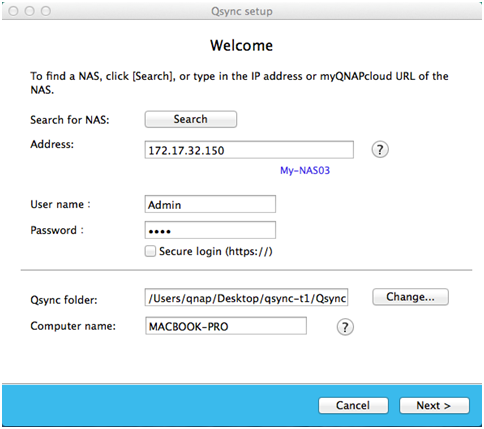
Note:
- If the ports have been changed for NAS connection, please append the port number to the IP address; otherwise, please only enter an IP address. (Default port number: 8080)
Start using Qsync
Click on the Qsync icon on the menu bar to bring up the menu.
![]()
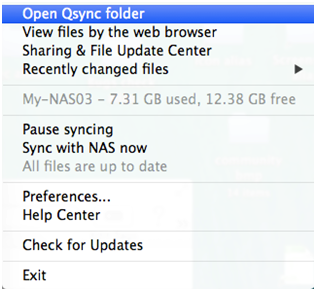

Now, just copy or move your files to the local Qsync folder in one of your devices, the files will be copied to all your other devices (devices with Qsync installed and are connected to the NAS.)
From now on, you don’t need to copy files back and forth between your PC and external devices or worry about the size of the files as you to try to attach them to an E-mail.
Synchronization
Synchronization
There are a few methods you can synchronize your files. Qsync will automatically synchronize the files among your computers or mobile devices that have Qsync installed, and they will also be synchronized to the Qsync folder on the NAS.
- For PCs, drag and drop files directly to the local Qsync folder.
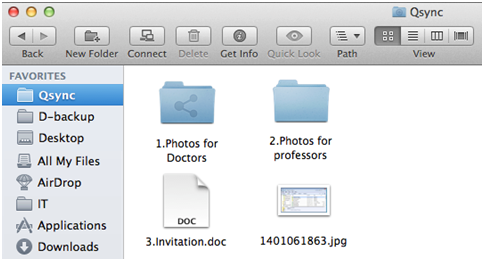
- For mobile devices (Qfile), copy or move files into the Qsync folder.
- For the NAS, copy or move files to the Qsync folder via File Station (web based file explorer).
Note:
- If files are “dragged and dropped” into the Qsync folder, they will be moved to the Qsync folder, as supposed to be copied into the folder, if the files and the Qsync folder are located in the same disk drive. The behavior is the same as File Explore in Windows.
- The maximum size of a single file that Qsync can transmit is 50G in a LAN.
- Qsync doesn’t support SAMBA, FTP or AFP for files access. Please access files using File Station or Qsync.
- Qfile can only synchronize the file list and does not download the files to a mobile device. Please download the files when you need them.
Offline editing
You can browse and edit your files offline, and once your device is online, Qsync will sync the files you edited offline for you automatically.
Sharing
Share files by download links
You can share files by sending file download links to those who haven’t installed Qsync.
- For Windows, right click on the file that you would like to share in the local Qsync folder and click on “Share the link.”
- Select to send the link via E-mail or copy the link to others.
- Click “Advance” to check more options for the link, such as creating a SSL link, the expiration date, or password.
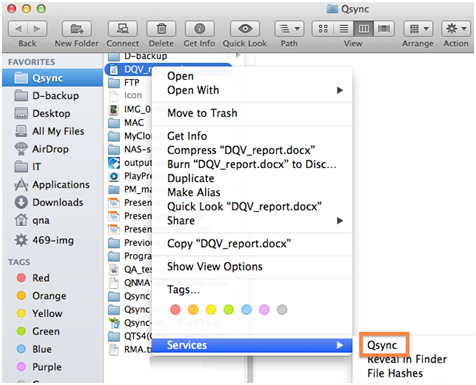
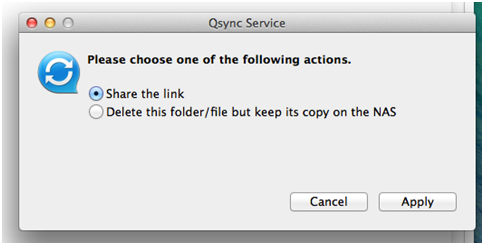
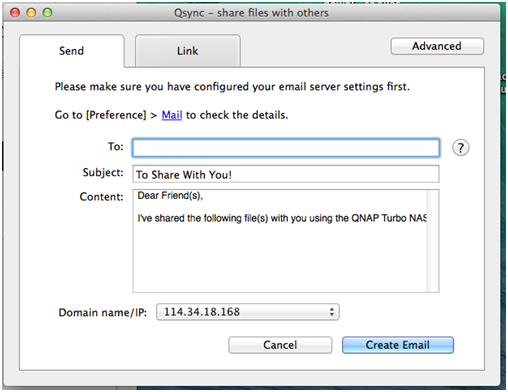
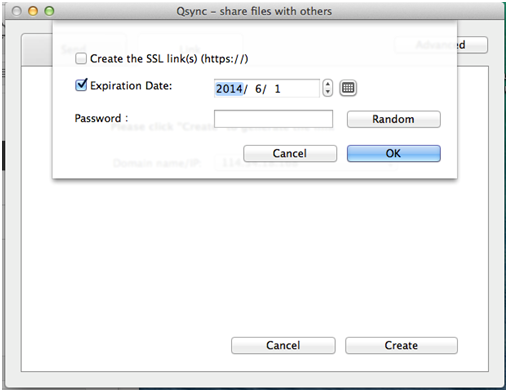
- For the NAS, right click on the file that you would like to share in the Qsync folder within File Station and click on “Share.”
- For mobile devices, launch Qfile to share the file in the Qsync folder by clicking the icon to the right and click “Share.”
- The file recipients can click on the link or copy and paste it to a web browser to download the file.
Share the folders with a group
You can share a folder with a group of users. If any member from the group shares the files in the folder, other members can receive the file.
Steps:
- Create user accounts in the NAS for each group member.
- Have Qsync utility installed on each member’s device.
- Right click on the folder that you would like to share in the local Qsync folder and click on “Share this folder as a team folder.”
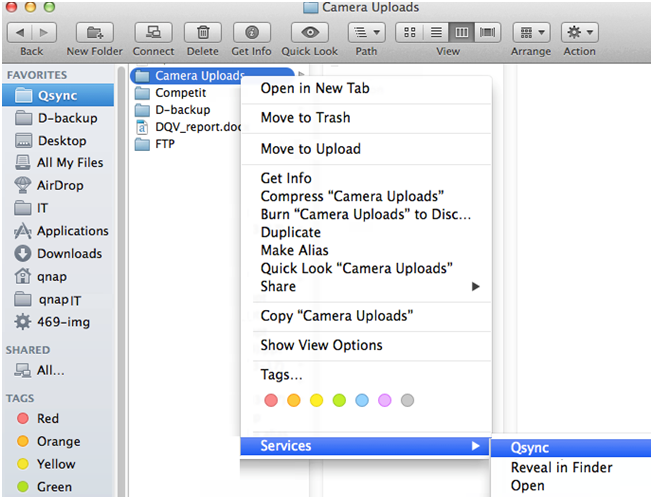
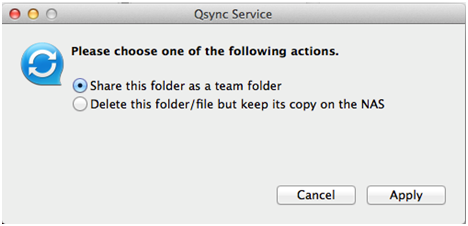
- Select users from the list of local or domain users.
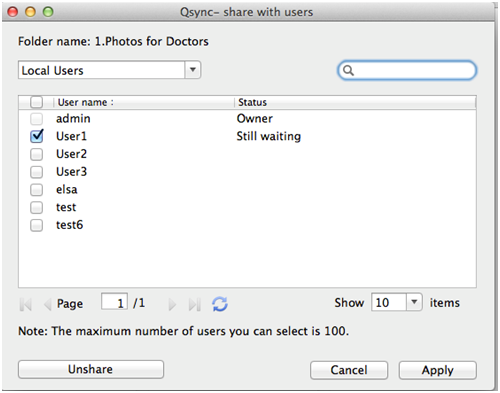
- All members in the group will receive a file sharing invitation. Once accepted, the group members can start to access this shared folder.
Note:
- The team folder will only take effect after users you send the invitation to accept the invitation.
- Users cannot share the team folders which are shared from others again.
Remote access
Access the NAS over the Internet
To connect to a remote NAS (over the Internet), the administrator is required to configure the device name for the NAS in “myQNAPCloud” first (Log into the NAS> NAS Desktop > Click on the myQNAPcloud shortcut.)
Next, notify the users about the myQNAPCloud web address for their remote access. You can then use the myQNAPCloud address to log into the remote NAS. ( e.g. andy@myQNAPcloud.com )
Note:
- The connection with the NAS over the Internet will take longer, when compared to a LAN environment.
- As you switch back to a LAN environment where your NAS is located, please connect to the NAS again through LAN, instead of the myQNAPcloud service for better connection quality.
- For better performance on file transmission, it is recommended to configure port forwarding on the router if possible.
Sync photos and videos automatically
Qsync can sync your photos and videos on mobile devices to the Qsync folder of across all Qsync clients automatically.
Steps:
- Install Qfile on your mobile devices by following instructions outlined in the Qsync page on the NAS or find it on the APP Store.
- Launch Qfile,
- Click “Settings” on the bottom right side of the screen,
- Scroll down and look for “Auto upload from photo gallery” and click on “Set up now,”
- Select a NAS to upload photos and videos to,
- Select the folder,
- Select “Use default setting” ( /Qsync/Camera Uploads) or select “Set up manually” to set the path,
- Select if you want to upload all photos from photo gallery immediately,
- You can tick the checkbox “Limit to WiFi” to upload files through WiFi and avoid possible expenses associated with the 3G Network,
- The uploaded files will be synced to the “Camera Uploads” folder under the Qsync folder on Qsync client devices.
Note: If files uploaded before are deleted from the Camera Uploads folder, Qfile will not upload those copies in the photo library again.
Synchronization Management
Synchronization management
Click on the Qsync icon on the taskbar to see the management functions:
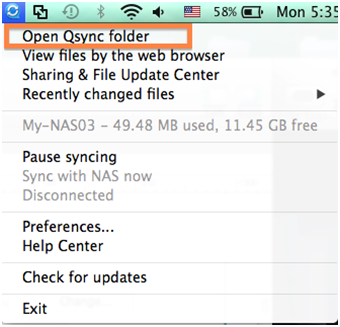
- Add files and view the synchronization result on the NAS:
- Open Qsync folder: Open the Qsync folder to add files,
- View files by the web browser: Open File Station (web based file explorer) and browse files in the Qsync folder on the NAS.
- Control synchronization progress:
- Pause syncing / Resume syncing: Click to pause or resume syncing,
- Sync with NAS now: Force Qsync to scan again and refresh the synchronization list.
- Information for syncing and sharing:
- Sharing & File Update Center
- File Update Center: List the file or folder update logs.
- Sharing center: List the folders or files shared with others. Users can choose to accept or decline the team folders. However, users cannot share team folders that are shared by others.
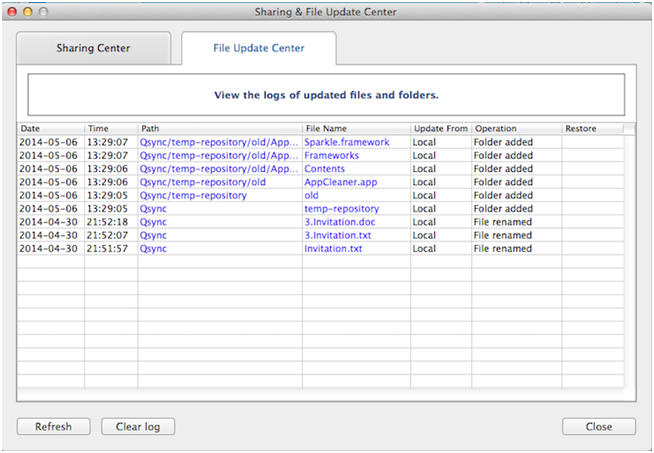
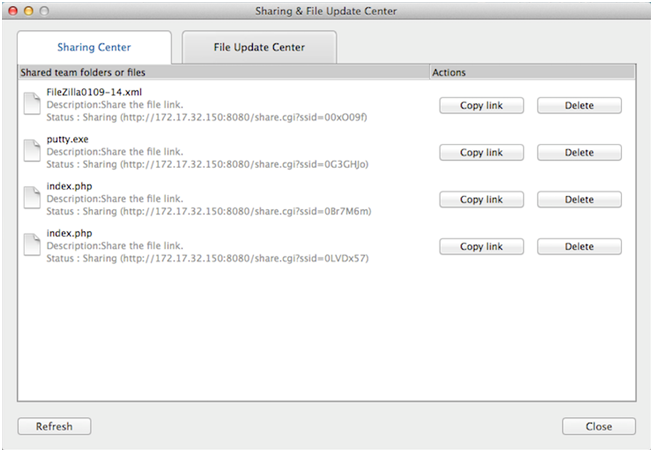
ii. Recently changed files: List the recently updated files.
- Sharing & File Update Center
- Preference:
- General:
- Link Status: Show the current status. Click “Logout” to change users.
- Network Recycle Bin: Browse or recover files deleted from the Qsync folder.
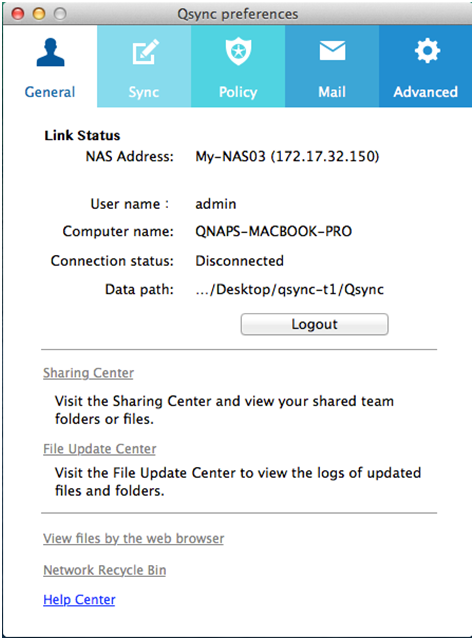
- Sync:
- Selective Synchronization: Select the folder to sync to the computers.
- Do not remove any files on the NAS when synchronizing: You can remove files within the local Qsync folder, and files deleted from your computer will not be synchronized with the NAS. The NAS still keeps copies of the deleted files.
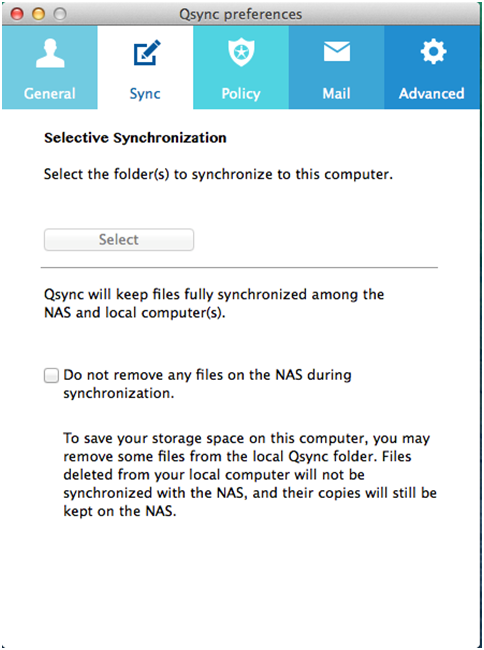
- Policy:
- Conflict Policies: The policies for handling the name conflicts between Qsync server (NAS) and clients after it is back online from its disconnection:
- Rename the local files(s),
- Rename the remote NAS files(s),
- Replace local files with remote NAS file(s), or
- Replace remote NAS files with local files(s).
- Sharing Policies: The policies of the team folders when other Qsync users share them to this local computer:
- Always reject sharing,
- Automatically accept sharing, or
- Send a notification message once sharing occurs.
- Filter Settings: During file synchronization, Qsync will not sync the types of files specified in filter settings.
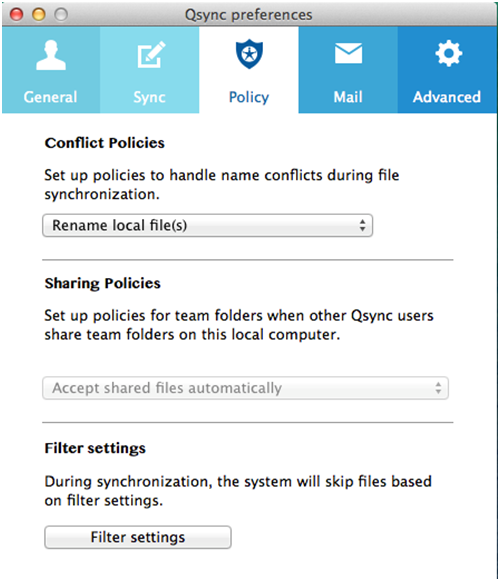
- Conflict Policies: The policies for handling the name conflicts between Qsync server (NAS) and clients after it is back online from its disconnection:
- E-Mail:
Set up E-mail: Set up an E-mail account for sharing file links. You can use the NAS SMTP server settings (for NAS administrator use only) or configure a new SMTP server.
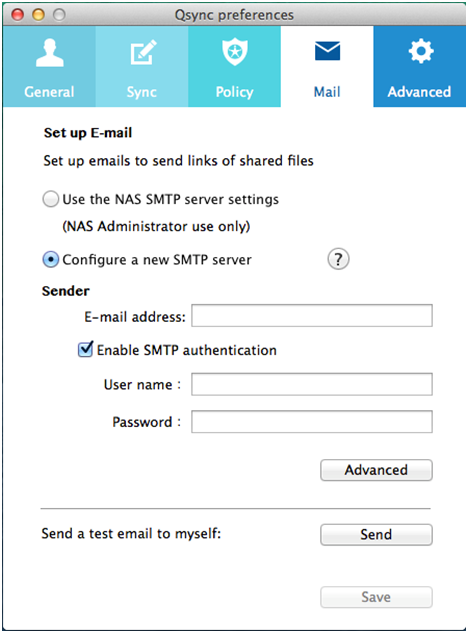
- Advanced:
Import photos and videos: Import photos and videos when an USB external device is connected. This feature only applies to photos and videos located under the DCIM folder in the root directory of the USB external device.
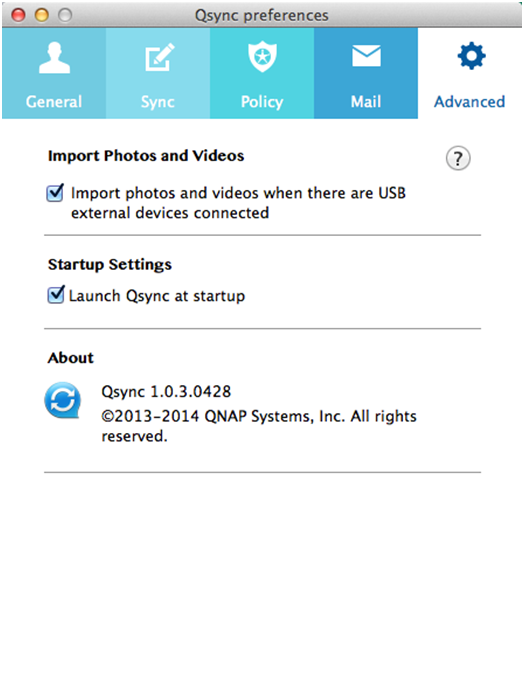
- General:
Manage or monitor Qsync status via web browser
Log into the NAS via a web browser and click the Qsync button.
- Overview: Provides links to install the utility and to File Station, lists the total number of online users and devices, and you can also choose to enable or disable the Qsync service (for administrator only.)
- Users: List information of online users and you can manage the Qsync service for users (For administrator only.)
- Devices: List the status of connected devices and you can choose to allow or terminate connection of the devices.
- If users log in from their PC, the name of the device will be shown as their computer name.
- If users log in from Qfile, the name of the device will be shown as Qfile-Android or Qfile-iPhone.
- If users move or copy files to the Qsync folder in File Station, the name of the device will be shown as Qsync-File Station.
- Event Logs: List the activity details by each user.
- Team folder: List the status of the team folder, including folders that you shared and are shared by others.
- Shared File Links: List the status of shared links.






























